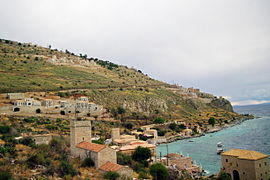Oitylo
Οίτυλο | |
|---|---|
 View of Limeni | |
| Coordinates: 36°42.4′N 22°23.3′E / 36.7067°N 22.3883°E | |
| Country | Greece |
| Administrative region | Peloponnese |
| Regional unit | Laconia |
| Municipality | East Mani |
| Area | |
| • Municipal unit | 218.582 km2 (84.395 sq mi) |
| Elevation | 251 m (823 ft) |
| Population (2021)[1] | |
| • Municipal unit | 3,643 |
| • Municipal unit density | 17/km2 (43/sq mi) |
| • Community | 474 |
| Time zone | UTC+2 (EET) |
| • Summer (DST) | UTC+3 (EEST) |
| Postal code | 230 62 |
| Area code(s) | 27330 |
| Vehicle registration | ΑΚ |
| Website | www.dimosoitilou.gr |
Oitylo (Greek: Οίτυλο, pronounced Ítilo), known as "Βίτσουλο", pronounced Vitsoulo, in the native Maniot dialect,[2] is a village and a former municipality in Laconia, Peloponnese, Greece. Since the 2011 local government reform it is part of the municipality East Mani, of which it is a municipal unit.[3]
Oitylo is one of the oldest towns in the Mani Peninsula. It was mentioned in the Iliad by Homer as Oetylus (Ancient Greek: Οίτυλος), as part of Menelaus' kingdom. In the Middle Ages, it grew to become the most important town in Messenian Mani. The only town in Mani that rivaled Oitylos in numbers of pirates was Skoutari.
Now Areopoli has taken Oitylo's place as the most important town in Laconian Mani. Areopoli was also the seat of the municipality of Oitylo, which is located on the western half of the Mani Peninsula in the extreme southwestern part of Laconia. It has a land area of 218.582 km2.[4] There are 91 villages in the municipality. The largest of these are Areópoli, Pyrgos Dirou and Oítylo.
- ^ "Αποτελέσματα Απογραφής Πληθυσμού - Κατοικιών 2021, Μόνιμος Πληθυσμός κατά οικισμό" [Results of the 2021 Population - Housing Census, Permanent population by settlement] (in Greek). Hellenic Statistical Authority. 29 March 2024.
- ^ "TA ΓNHΣIA ONOMATA TΩN XΩPIΩN THΣ MEΣA MANHΣ KAI H ΣΩΣTH ΠPOΦOPA KAI ΓPAΦH TOYΣ ΜΕΡΟΣ B' | Mani Voice". Archived from the original on December 13, 2014. Retrieved December 4, 2014.
- ^ "ΦΕΚ B 1292/2010, Kallikratis reform municipalities" (in Greek). Government Gazette.
- ^ "Population & housing census 2001 (incl. area and average elevation)" (PDF) (in Greek). National Statistical Service of Greece.

